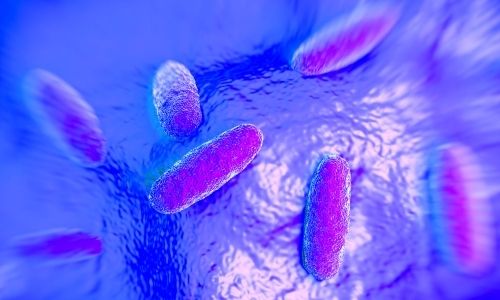
When you hear about Salmonella, the first thing that comes to mind is usually chicken. And for a good reason – Salmonella is a bacteria that can be found on raw chicken, and it’s responsible for causing food poisoning in people all over the world.
So, the question on everyone’s mind is: does freezing chicken kill Salmonella? The answer is no. That will not do the job! It might stop the bacteria from growing or multiplying, but only cooking the food at the right temperature will kill it.
To better understand the relationship between Salmonella and Chicken, let’s break down a couple of facts for you!
What Is Salmonella?

Salmonella is a bacteria that can cause food poisoning in humans. It’s usually found in raw chicken, but it can also be found in other raw meats, eggs, and dairy products. When these contaminated foods are consumed, the salmonella bacteria can cause an infection in the person’s body.
Diarrhea, vomiting, fever, and cramps are common symptoms of salmonella infection. These symptoms usually last for 4-7 days, and most people recover without any treatment.
However, the infection can be more severe in some cases, especially in young children, older adults, and people with weakened immune systems.
In these cases, the infection can spread from the intestines to the bloodstream and then to other body parts. This can be very dangerous, and it may require hospitalization.
How Common is Salmonella in Chicken? How do I know if my chicken has Salmonella?

Unfortunately, Salmonella is quite common in chickens. It’s estimated that about 1 in 20,000 chickens are infected with the bacteria.
This might not sound like a lot, but it’s important to remember that chickens are typically sold in packages of 4-6, so you could quickly end up with an infected chicken if you’re not careful. Salmonella is also common in other raw meats, eggs, and dairy products.
The most basic signs of Salmonella are weakness, poor growth, and loss of appetite in the flock.
Does Freezing Chicken make it Safer?
Salmonella can survive in the freezer. It can survive in temperatures as low as -10°F. However, it’s important to note that the bacteria will not multiply at these low temperatures. Other bacteria, such as Listeria monocytogenes, can survive and grow at these temperatures, but Salmonella cannot.
Does Cooking Chicken Kill Salmonella?
The good news is that Salmonella is killed at cooking temperatures. The CDC (Centers for Disease Control and Prevention) recommends cooking chicken to an internal temperature of 165°F to kill the bacteria.
If you do this, you can be confident that the bacteria have been killed. You should also note that it’s essential to cook the chicken all the way through – not just the parts you plan to eat.
You should also know that this is that the bacteria can be present on the outside of the chicken, but not necessarily on the inside.
Tips To Prevent Salmonella Infection At Home
The best way to kill Salmonella in chicken is to cook it to an internal temperature of 165°F. This can be accomplished by cooking the chicken in various ways, such as baking, roasting, grilling, or frying.
If you’re not sure whether or not the chicken is cooked all the way through, you can use a food thermometer to check. Simply insert the thermometer into the thickest part of the chicken, and make sure that the internal temperature is advised.
In addition to cooking chicken to the proper temperature, you can do a few other things to reduce your risk of getting food poisoning from Salmonella.
Wash Your Hands
First, make sure to wash your hands thoroughly after handling raw chicken. It would help if you also washed any utensils, cutting boards, or countertops that have contacted the chicken.
Keep Raw Meat Separate
It’s also good to avoid cross-contamination by keeping raw chicken separate from other food in your kitchen. This means storing it in a sealed container and cooking it on a clean surface.
Cook Your Food
Finally, make sure to cook the chicken as soon as possible after buying it. Raw chicken can contaminate other food in your fridge, so it’s best to cook it right away.
Maintain Food Hygiene
Maintain basic food hygiene while handling raw chicken. For example, store it in the refrigerator, use a food thermometer to check the temperature, cook it thoroughly, wash your hands and the utensils properly, etc.
Don’t Leave Food Out Too Long
Maintain a 2-hour rule, and do not leave your food outside for too long. Exposure to unreliable temperatures can cause Salmonella Enteritidis, Campylobacter, Staphylococcus, etc., to grow. This can cause grave harm to your health.
Can Cooked Chicken Contain Salmonella?

Yes, you can get Salmonella from cooked chicken that has been left out. The bacteria can survive in cooked chicken for up to four hours at room temperature.
This is why it’s so important to make sure that you eat chicken that has been cooked all the way through and is still hot. If you’re not sure whether or not the chicken is safe to eat, it’s best to err on the side of caution and throw it out.
FAQs
Which Foods Can Contain Salmonella?
As opposed to popular opinion, salmonella is not just present in meat like chicken, turkey, pork, beef, or eggs. It can also be found in vegetables, fruits, processed foods, frozen pot pies, etc.
What temperature kills salmonella in eggs?
Since eggs can contain Salmonella, it is necessary to cook them at the right temperature, preferably at 160- degrees Fahrenheit.
What temperature kills salmonella in chicken?
Cooking chicken at 65 degrees Fahrenheit will kill salmonella or any other kinds of bacteria.
Does freezing chicken kill bacteria?
Freezing chicken or any meat will not kill bacteria. But it might stop other bacteria from growing. The only way to kill bacteria is by cooking the food.
Conclusion
In conclusion, it’s essential to be aware that Salmonella is a bacteria that can survive in chicken, even in the freezer.
The best way to kill Salmonella in chicken is to cook it to an internal temperature of 165°F. However, the bacteria will not multiply at these low temperatures.
You can also reduce your risk of getting food poisoning by washing your hands thoroughly after handling raw chicken and cooking it as soon as possible.
Finally, avoid cross-contamination by keeping raw chicken separate from other food in your kitchen.
Did you find this article helpful? Comment down below and let us know.



